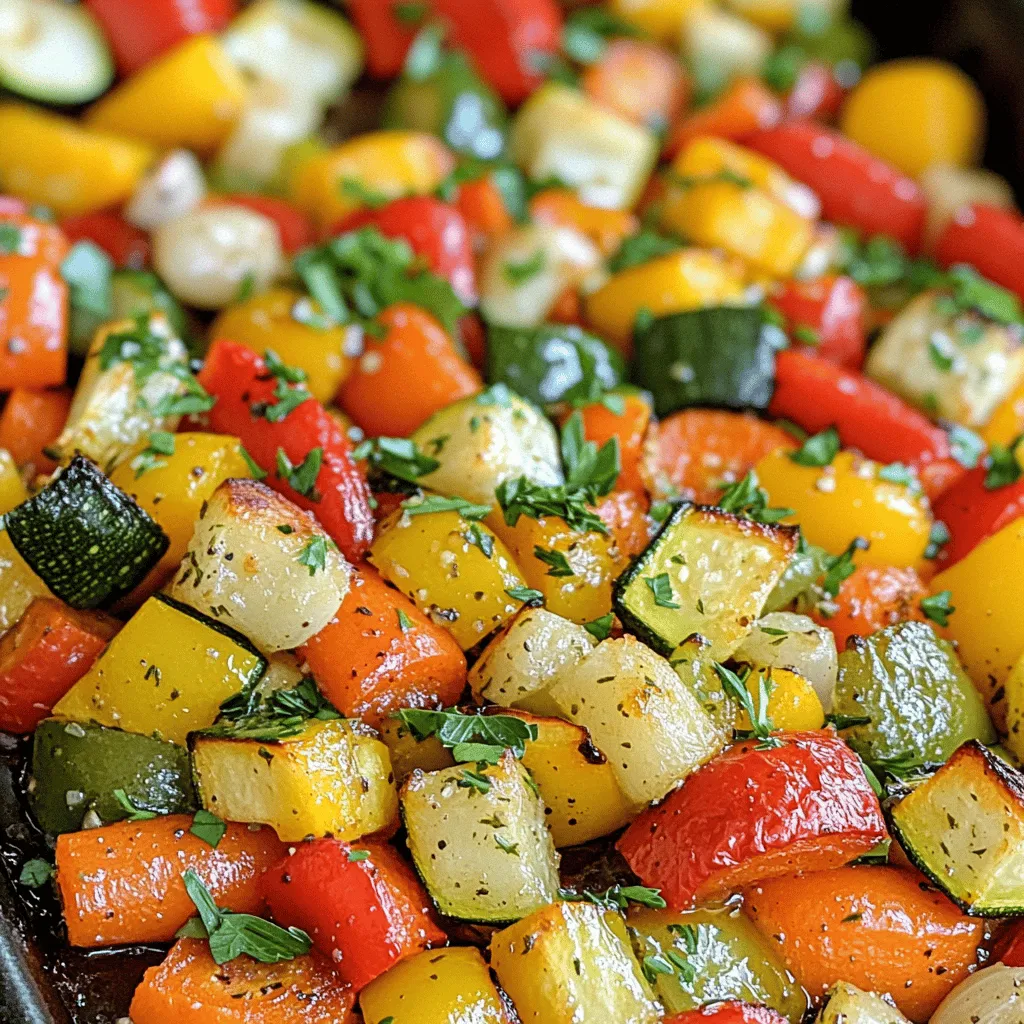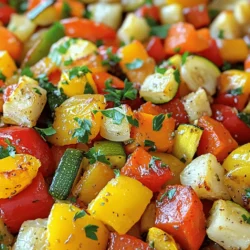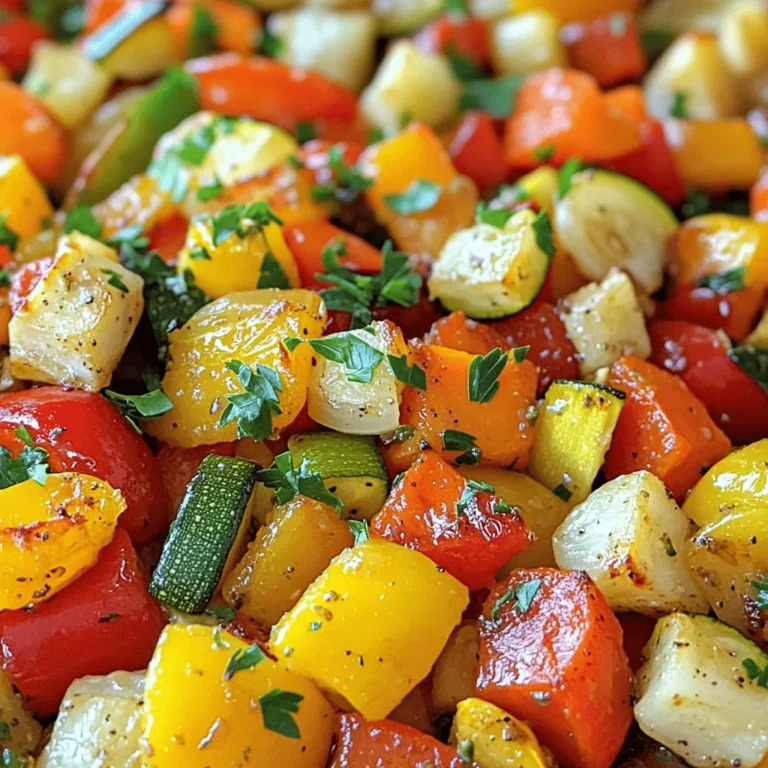Are you looking for a simple, tasty way to enjoy your veggies? Garlic Herb Roasted Vegetables are the answer! This easy dish packs a punch with flavors that will make anyone love eating their greens. In this post, I’ll share a quick guide on ingredients, step-by-step instructions, and clever tips to make your veggies shine. Let’s dive in and start roasting deliciousness today!
Ingredients
List of Ingredients
– 2 cups carrots, peeled and sliced
– 2 cups bell peppers (red, yellow, and green), diced
– 2 cups zucchini, sliced
– 1 red onion, chopped
– 4 cloves garlic, minced
– 3 tablespoons olive oil
– 1 teaspoon dried thyme
– 1 teaspoon dried rosemary
– 1 teaspoon paprika
– Salt and pepper to taste
– Fresh parsley, chopped (for garnish)
Garlic herb roasted vegetables shine with bright flavors. Each veggie brings its own taste.
– Carrots: Sweet and earthy, they add a nice crunch.
– Bell Peppers: Colorful and juicy, they bring a mild sweetness.
– Zucchini: Soft and tender when cooked, it has a mild flavor.
– Red Onion: Sweet and slightly sharp, it adds depth.
For herbs and spices, thyme and rosemary work well together. Paprika adds a hint of smokiness. You can mix and match these flavors to suit your taste. Try adding oregano or basil for a different twist.
This dish is not just pretty; it’s also healthy and packed with nutrients.
Step-by-Step Instructions
Preparation Steps
Prepping the Vegetables
First, wash your vegetables. Peel and slice 2 cups of carrots. Dice 2 cups of bell peppers in red, yellow, and green. Slice 2 cups of zucchini and chop 1 red onion. Keep all these veggies ready in a large bowl.
Making the Garlic Herb Mixture
In a small bowl, mix 4 cloves of minced garlic with 3 tablespoons of olive oil. Add 1 teaspoon each of dried thyme, dried rosemary, and paprika. Season this blend with salt and pepper to your taste. This mixture adds great flavor.
Combining and Coating the Vegetables
Pour the garlic herb mixture over your prepared vegetables. Toss them well to coat every piece evenly. This step ensures that all the veggies soak in that tasty flavor.
Roasting Instructions
Oven Temperature Settings
Preheat your oven to 425°F (220°C). This high heat helps the veggies caramelize and get tender.
Arranging the Vegetables on the Baking Sheet
Line a baking sheet with parchment paper. Spread the coated vegetables evenly in a single layer. Avoid overcrowding to allow even cooking.
Roasting Time and Tips
Roast the veggies for about 25-30 minutes. Stir them halfway through to ensure even roasting. Look for a nice golden color and a tender texture when they are done.
Final Touches
How to Serve the Roasted Vegetables
Once roasted, let them cool for a few minutes. Transfer them to a serving dish for a beautiful presentation.
Garnishing Options
Sprinkle fresh parsley on top for a pop of color. This garnish also adds a fresh taste.
Suggested Pairings or Side Dishes
Serve these roasted veggies with grilled chicken or fish. They also pair well with rice or quinoa for a hearty meal.
Tips & Tricks
Pro Tips for Perfect Roasting
– Achieving Optimal Crispiness
To get crispy veggies, choose a hot oven. I like to preheat to 425°F. This high heat helps the vegetables caramelize. Spread them out in a single layer on the baking sheet. Crowding them makes them steam instead of roast.
– How to Avoid Soggy Vegetables
Use fresh, dry vegetables. If they are wet, they will steam and turn soggy. Pat them dry with a towel before roasting. Also, don’t skip the oil. It helps crisp up the edges.
– Importance of Cutting Vegetables Evenly
Uniform cuts ensure even cooking. Try to cut all vegetables into similar sizes. This way, they cook at the same rate. For example, slice carrots and zucchini about the same thickness.
Customization Tips
– Adding Additional Vegetables
Feel free to mix in your favorite vegetables. Broccoli, asparagus, or sweet potatoes all work well. Just make sure they roast at a similar time as your main veggies.
– Including Protein Options
Want to make it a full meal? Add protein like chicken or tofu. Cube them up and toss them with the veggies. You’ll have a tasty, balanced dish.
– Adjusting Flavor with Different Herbs
Switch up the herbs to change the flavor. Try basil or oregano for a different taste. Fresh herbs can also add a nice touch at the end.
Common Mistakes to Avoid
– Overcrowding the Baking Sheet
This is a big mistake. If you pile vegetables on top of each other, they won’t roast. Instead, they’ll steam and become mushy. Always leave space between each piece.
– Not Preheating the Oven Properly
I can’t stress this enough. Preheating is key to good roasting. If your oven isn’t hot enough, your vegetables won’t cook right.
– Incorrect Seasoning Ratios
Balance is crucial in seasoning. Too much salt can ruin the dish. Start with a little and adjust as you go. Taste the mixture before adding more.

Variations
Seasonal Variations
Using seasonal vegetables keeps your dish fresh and tasty. In spring, try asparagus and peas. In summer, add eggplant and tomatoes. Autumn calls for squash and Brussels sprouts. In winter, root veggies like parsnips and turnips shine. Adjust your recipe based on what is in season. This makes your meal vibrant and full of flavor.
For holiday meals, roasted vegetables can add color and taste to your table. You can use a mix of festive colors like red and orange bell peppers. Add seasonal herbs like sage or thyme to enhance the dish. These small tweaks can turn a simple side into a showstopper for your gatherings.
Flavor Profile Adjustments
You can easily change the flavor of your roasted vegetables. For a richer taste, try different oils. Avocado oil adds a subtle flavor. Grapeseed oil offers a light, nutty taste. Each oil can change the dish’s profile while keeping it healthy.
Adding vinegar can also boost the flavor. Balsamic vinegar gives a sweet tang, while apple cider vinegar adds brightness. Experiment with these options to find what you love.
Cheese can be a great topping. Parmesan brings a salty kick, while feta offers a creamy texture. You can even sprinkle some goat cheese on top. These toppings can elevate your vegetables and make them even more delicious.
International Twists
For a Mediterranean twist, add olives and sun-dried tomatoes. Toss in some capers for a briny punch. You can also mix in fresh basil or oregano. These additions create a vibrant dish that transports you to sunny shores.
For an Asian-inspired version, use sesame oil instead of olive oil. Add soy sauce for a savory depth. Toss in some sliced mushrooms and bok choy for a fresh crunch. These flavors create a unique take on roasted veggies that is both exciting and comforting.
Explore these variations to make your garlic herb roasted vegetables even more delightful. Each option gives you a chance to get creative in the kitchen.
Storage Info
How to Store Leftovers
To keep your Garlic Herb Roasted Vegetables fresh, follow these tips:
– Best Practices for Refrigeration: Allow the vegetables to cool completely. Place them in an airtight container. Store in the fridge for up to three days. This helps maintain their flavor and texture.
– Freezing Suggestions for Long-Term Storage: If you want to keep them longer, freeze the leftovers. Spread the cooled vegetables on a baking sheet. Freeze for a few hours until firm, then transfer to a freezer-safe bag. They will last up to three months in the freezer.
Reheating Guidelines
Proper reheating can bring back the veggies’ taste and texture:
– Best Methods for Reheating Roasted Vegetables: Use your oven or a skillet. For the oven, preheat to 375°F (190°C). Spread veggies on a baking sheet and reheat for about 10-15 minutes. In a skillet, heat over medium-low heat. Stir often until warmed through.
– Tips for Maintaining Texture and Flavor: Avoid using the microwave if possible. It can make the vegetables soggy. Add a dash of olive oil when reheating to boost flavor.
Shelf Life
Knowing how long your leftovers last is important:
– Expected Storage Times in the Fridge: When stored properly, Garlic Herb Roasted Vegetables last about three days in the fridge.
– Signs of Spoilage to Look Out For: Check for off-smells or slimy textures. If the colors look dull or faded, it’s best to toss them. Always trust your senses when it comes to food safety.
FAQs
Can I use other vegetables?
Yes, you can use many types of vegetables. Some great options include:
– Broccoli
– Cauliflower
– Sweet potatoes
– Asparagus
– Brussels sprouts
These vegetables add different flavors and textures. You can also mix and match. Just ensure they roast well at the same temperature. If you have seasonal vegetables, use those for freshness. They often taste better and are more nutritious.
How can I make this recipe vegan?
Making this dish vegan is easy! Simply replace the olive oil with a vegan-friendly oil. You can use:
– Avocado oil
– Coconut oil
Both options work well. Ensure your herbs and spices are vegan too. This recipe already is plant-based, so enjoy without any animal products.
What can I serve with Garlic Herb Roasted Vegetables?
This dish pairs well with many main courses. Try serving it with:
– Grilled chicken or fish
– Quinoa or rice
– Pasta dishes
For special occasions, serve it alongside roasted meats or at a potluck. The colors and flavors will impress any guest.
This guide walks you through making delicious Garlic Herb Roasted Vegetables. You learned the best ingredients, preparation steps, and roasting tips. I shared how to avoid common mistakes and create your own variations. Remember to store leftovers properly and reheat them for the best taste. Roasting vegetables brings out their flavor and adds joy to meals. Try new combinations to keep it exciting. Enjoy the crunch, color, and taste in every bite!


